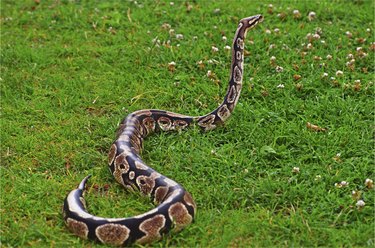While great diversity exists among the 41 species of the Pythonidae family, all species share a few common python characteristics, such as laying eggs, using constriction to kill their prey, having extra legs and lungs, and having thermal heat sensors. However, as pythons often fill different niches depending on their size, some characteristics change throughout their lives. Most small python species make excellent pets, but some grow too large for novices.

Video of the Day
Python characteristics: Leftover legs and lungs
Snakes arose from within the lizard lineage; they diversified over time into the nearly 3,500 extant species. Pythons form one of the most ancient snake lineages. They have retained a few anatomical features that have been lost in more advanced species, such as garter snakes (Thamnophis spp.), cottonmouths (Agkistrodon piscivorus ssp.) and cobras (Naja spp.)
Video of the Day
The most obvious retained feature of pythons is his anal spurs, which are actually vestigial legs. While not used for locomotion, males have larger spurs than females. They use them during male versus. male combat and while courting females. Additionally, while most advanced snake species have only one functional lung, pythons have two.
Pythons kill with constriction
Like all living snakes, pythons are obligate carnivores. When pythons notice suitable prey, they strike, grip it with their teeth, and pull the prey item towards them. As this is happening, the snake simultaneously begins coiling around the animal. Constriction kills the prey animal by suffocation rather than by breaking its bones.
When the python feels its prey's breathing and heart stop, it will release the prey and begin searching for its head. Pythons normally swallow their prey whole and head-first, but sometimes they may swallow it backward or sideways. While the diet of wild pythons occasionally includes lizards or large mammals, most captive pythons thrive on a diet of commercially-raised rodents - most even learn to accept dead rodents offered from tongs.
Ontogenetic changes in pythons
Like many other snakes, several pythons exhibit age-related changes in dietary preference and appearance over the course of their lives. Called ontogenetic changes, they are common to many species of the genus Morelia, which includes the carpet (Morelia spilota ssp.) and green tree pythons (Morelia viridis.)
These species usually prefer to eat lizards, frogs, or insects as juveniles. However, as these species age, they begin preferring rodents and birds to cold-blooded prey. These same snakes also change color as they grow. While carpet pythons exhibit relatively gradual color changes, green tree pythons, which are red or yellow at the time of hatching, sometimes change colors in a matter of days or weeks. Green tree pythons turn from brick red or yellow to green between six months and one year of age, and this color change is not related to sexual maturity.
Pythons lay eggs
Pythons are oviparous animals, meaning the females deposit shelled eggs that hatch about two to three months later. All female pythons coil around their eggs after they deposit them. This helps protect the eggs from predators and ensure the proper environmental conditions for egg development. Some pythons, including reticulated (Python reticulatus) and African rock pythons (Python sebae) twitch their muscles repeatedly to raise their body temperature, which accelerates egg development.
Pythons have thermal sensors
Like some boas (Boidae) and pit vipers (Crotalidae), pythons have thermally receptive pits located near their mouth. The pits detect the infrared energy emitted by predators or prey, and then relay this information to the brain, where the image is superimposed over the image produced by their eyes. This allows pythons to "see" warm objects, even in complete darkness.